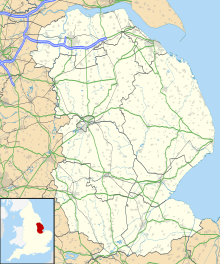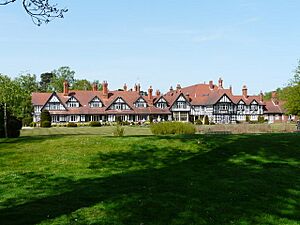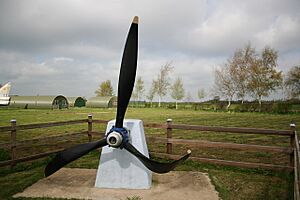RAF Woodhall Spa facts for kids
Quick facts for kids
|
|
|---|---|
| Summary | |
| Airport type | Military |
| Owner | Air Ministry |
| Operator | Royal Air Force |
| Location | Tattershall Thorpe, Lincolnshire, England |
| Built | 1941 |
| In use | 1942-1965 |
| Elevation AMSL | 33 ft / 10 m |
| Coordinates | 53°07′54″N 0°11′04″W / 53.13167°N 0.18444°W |
| Map | |
RAF Woodhall Spa was a Royal Air Force (RAF) base in Lincolnshire, England. It was an important airfield during World War II, especially for bomber planes. The base was located about 2 miles (3.2 km) north of Coningsby.
Contents
History of RAF Woodhall Spa
RAF Woodhall Spa opened in February 1942. It started as a smaller, supporting base for RAF Coningsby. In 1943, it became a main base for No. 54 Base Substation. After the war in Europe ended in May 1945, the airfield was used to get planes ready for a big bomber force called "Tiger Force." This force was planned to fight in the Far East.
After World War II, the airfield closed down. It was then used by No. 92 Maintenance Unit to store bombs. Later, in the late 1950s, the base became home to Bristol Bloodhound missiles. These were large rockets used for defense. Most of the site was sold off in 1964. The missile site was later used to fix jet engines for planes like the McDonnell Douglas F-4 Phantom II and Panavia Tornado. It finally closed in 2003.
Squadrons at Woodhall Spa
Many important RAF squadrons were based here during the war.
97 Squadron
97 Squadron moved to Woodhall Spa in March 1942. They were one of the first squadrons to fly the Avro Lancaster bomber. They took part in many early missions with this aircraft. One famous mission was a low-level attack on a factory in Augsburg, Germany, in April 1942.
A pilot named Les Munro served with 97 Squadron here. He later joined the famous 617 Squadron, known as the "Dambusters." He returned to Woodhall Spa with 617 Squadron in 1944.
619 Squadron
619 Squadron was formed at Woodhall Spa in April 1943. They later moved to RAF Coningsby in January 1944.
617 Squadron (The Dambusters)
The famous 617 Squadron arrived at Woodhall Spa with 34 Lancaster bombers. They also had 2 de Havilland Mosquito planes. These Mosquitoes were used to mark targets from a low height. 617 Squadron stayed at Woodhall Spa until the end of the war. They were pioneers in using very large bombs called Tallboy and Grand Slam bombs from this airfield.
627 Squadron
The way 617 Squadron marked targets was very successful. So, 627 Squadron, which flew Mosquito planes, was sent to Woodhall Spa. They helped mark targets for the bombers. They arrived in April 1944 and stayed until the end of the war.
Amazing Missions from Woodhall Spa
Planes from RAF Woodhall Spa carried out many important missions:
- They dropped the first 12,000-pound Tallboy bombs. One mission blocked the Saumur railway tunnel in France. This tunnel was key for supplies going to Normandy.
- They attacked enemy submarine bases at La Pallice and Lorient. They also destroyed enemy boat pens at Le Havre.
- During a raid on Brest, they sank the French cruiser Gueydon.
- They attacked Swinemünde and sank the German cruiser Lützow with a single Tallboy bomb.
- The huge German battleship Tirpitz was sunk in Norway on November 12. This was done by planes from Woodhall Spa and RAF Bardney.
- The very last raid from Woodhall Spa was an attack on Hitler's home, the Berghof, near Berchtesgaden.
The Petwood Hotel
The Petwood Hotel was originally a country house. It was built by Sir Archibald Weigall and his wife, Grace Emily. Lady Weigall called it "Petwood" because it was built with her favorite wood. In 1933, it became a hotel.
When World War II started, the Petwood Hotel was taken over by the RAF. It became the Officers' mess for the base. This was a place where the officers lived, ate, and relaxed. The hotel had nice rooms and big gardens. It was a comfortable place for the officers. Many parties were held there, including a celebration for the Dambuster raids. After the war, the Petwood Hotel became a hotel again. They kept a small bar just as it was during the war.
Post-War Operations
In 1960, RAF Woodhall Spa became a base for Bristol Bloodhound Surface-to-air missiles. These missiles were operated by 222 Squadron.
Later, in 1964, 112 Squadron took over this role. The missiles were upgraded to a newer version. This squadron then moved to Cyprus in 1967 and stayed there until 1975.
Front-line flying stopped at RAF Woodhall Spa in 1967. However, the RAF kept a small part of the base from 1968 to 1992. They used it to fix and test jet engines. This site was known as RAF Woodhall and worked with nearby RAF Coningsby.
RAF Woodhall Spa Today
Today, not much of the old RAF Woodhall Spa base remains. However, part of one of the old buildings is now the Thorpe Camp Visitor Centre. This center remembers the brave people who served in World War II. It has many exhibits about RAF Woodhall Spa and what life was like during the war.
Much of the land where the base once stood was used as a gravel quarry. In 2015, the Lincolnshire Wildlife Trust bought the site. They wanted to protect its history and create a new nature reserve. This new reserve connects with another reserve nearby. The land has sandy soil, grassy areas, heathland, and small wet areas.
|





